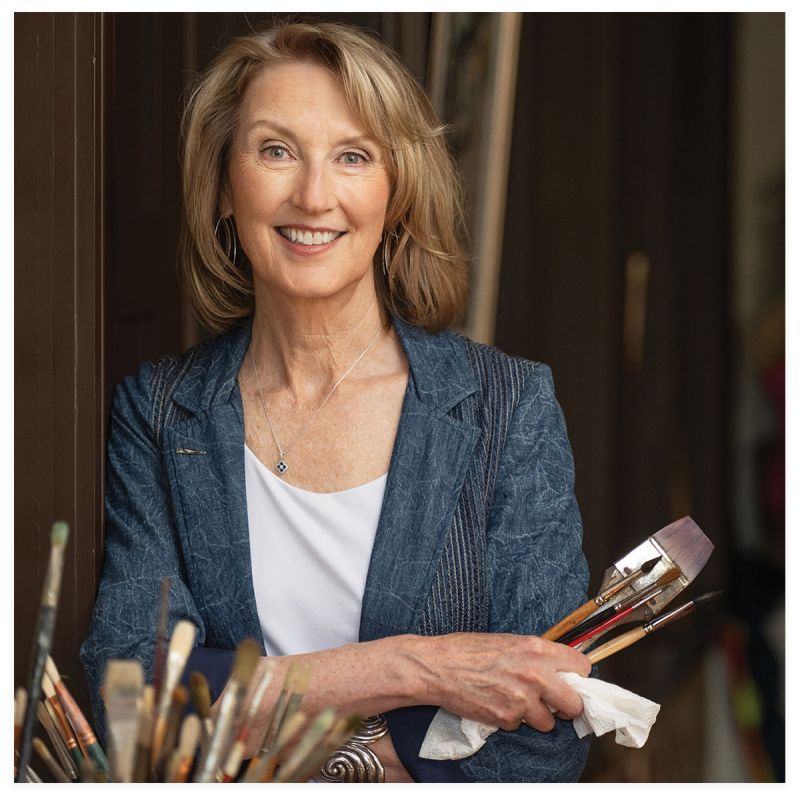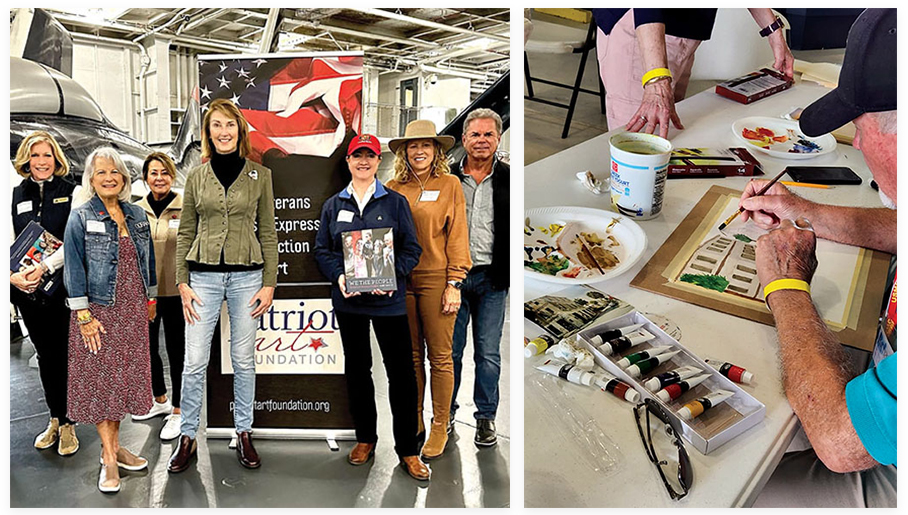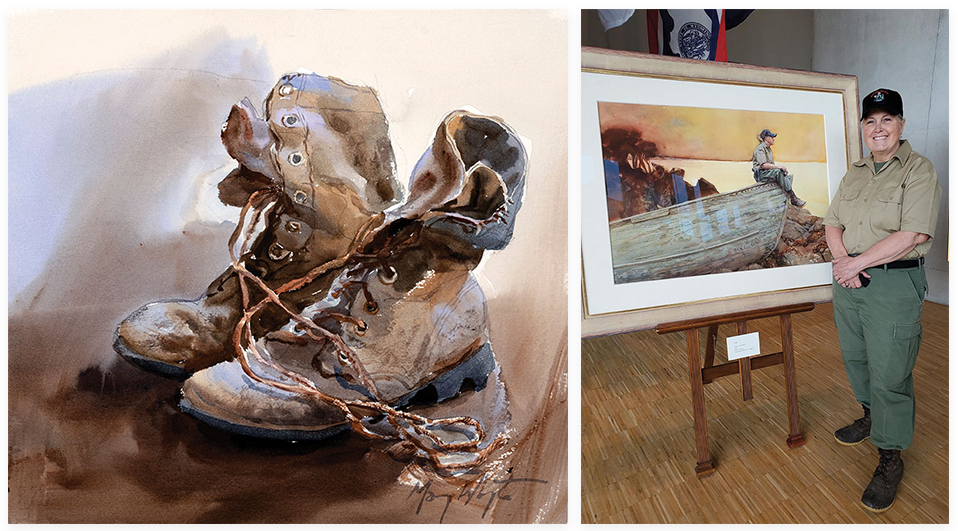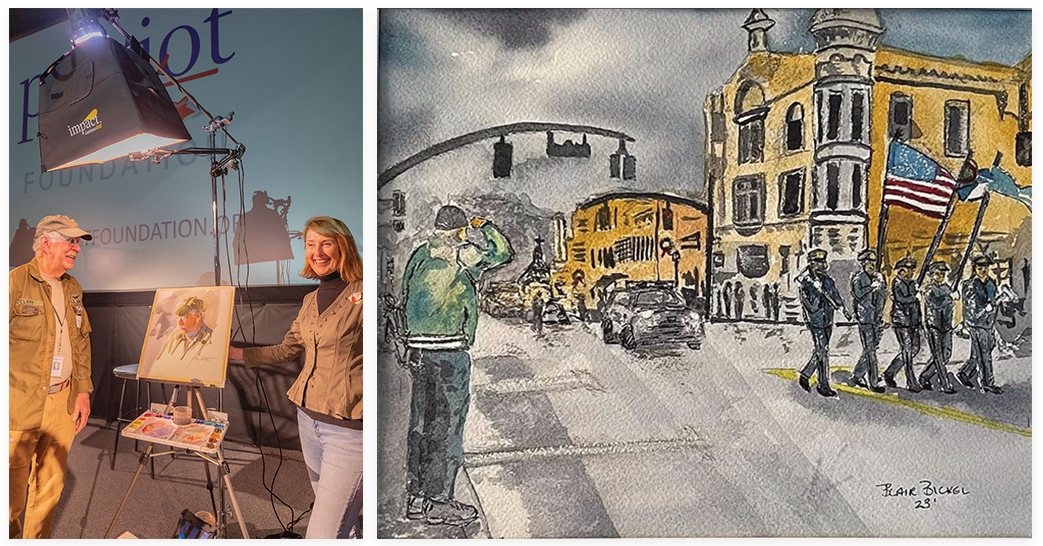Now, her palette includes giving veterans a voice

Dazzling morning light whispers in through the windows of Mary Whyte’s studio. A second-floor space fronting Meeting Street—just a few doors down from the Gibbes Museum of Art where, in neighborly fashion, several of Whyte’s works reside—the studio’s old, exposed brick walls suggest a sturdy staying power that feels apropos.
In her graceful, soft-spoken way, Mary Whyte has been an enduring force in the regional and national art world since the Midwesterner moved to the Lowcountry more than three decades ago. Her work has the airy, ephemeral quality intrinsic to watercolor, yet with a piercing poignancy, a raw realism that somehow feels more authentic than a photograph. It’s Whyte’s superpower—distilling essence, emotion, and truth via only pigment, brush, and water.
Whyte is celebrated for her portraiture, and indeed the studio feels alive, peopled by some of those whom she’s rendered in watercolor—a woman harvesting a pumpkin, the last remaining Chinese fortune cookie maker in San Francisco, a young man in a hoodie, several self-portraits, and works in progress. The informal gallery walls include a few outtakes from her 2003 exhibition and publication “Alfreda’s World,” in which Whyte portrayed Alfreda LaBoard and the Gullah women she’d come to know who lived along Bohicket Road on John’s Island, each portrait lovingly awash with the dignity, strength, and beauty embodied by these women. There are images from “Working South,” a 2011 traveling exhibition and publication for which Whyte turned her documentarian eye to the shoe shiners, shrimpers, and oystermen, the hat makers and others whose skills and largely rural jobs were being lost to an ever industrialized, globalized economy. In each painting, Whyte hones in on the vibrant, meaningful, and sometimes arduous life inherent in their livelihoods. Her portraits pulse with unvarnished, honorable grittiness.
The author of seven books and the subject of one biography, Whyte has earned acclaim for works such as these, including the Portrait Society of America’s Gold Medal, the Carolinas Freedom Foundation’s Freedom Award, and the South Carolina Governor’s Award for the Arts, the state’s highest honor in the arts. In 2020, she received the National DAR Medal of Honor and the National Society DAR Women in the Arts Award, and in 2021, Converse University in Spartanburg bestowed her an honorary doctorate. Despite the accolades, there remains a humility, a hardworking ethos in Whyte’s studio, where she stores dozens of used brushes in an elegantly tarnished silver tea service—a high school graduation gift from her grandmother. “I’ve never made tea in it,” she says.

(Left) An army of volunteers help staff events, including (left to right) Cathy Sippell, Susan Marlowe, Mary Regner, Whyte, Mille Haehl, Phyllis Sheffer, Martha Waggoner, and General Charles Baldwin on the Yorktown on Veterans Day 2023; (right) Patriot Art Foundation classes are as much about offering sense of community and connection as they are exploring the healing power of art.
New Strides
No, Whyte is less a fancy afternoon tea lady than a roll-your-sleeves-up artist, a work-boot gal. To wit: hanging amid the portraits, there’s a framed still life of a pair of worn boots. Even the inanimate footwear—laces tangled and pooled at the side, the tops slumped over, tatty and exhausted—are kicking with character. You can feel their laden steps, the miles they’ve trod, as if Whyte has given the saying, “if you could walk a mile in my shoes…” leathery gravitas.
That empathy, the sense of compassion and understanding the aphorism suggests, is at the heart of her artistry. It’s the muscle that allows Whyte to bring subjects forth in a way that, as Gibbes Museum executive director Angela Mack says, makes it seem “as if they were all her close friends.”
Like the people she paints, the boots feel well-loved and deeply known. They also symbolize the current strides Whyte is making in expanding that sense of connection, of being seen and understood, beyond works on paper and into the lives of those represented in her most recent body of work, “We the People: Portraits of Veterans in America,” through the Patriot Art Foundation.
Whyte created the foundation to give veterans the tools and ability to use art as a means of self-expression, healing, and connection. It’s an ongoing extension of “We the People,” her most ambitious and challenging project to date. Featuring 50 large-scale portraits of United States veterans from all walks of life, the project took Whyte seven years to complete, debuting at the City Gallery in 2019. “It was important to me to do it without input or steerage from others, so I kept it private,” she explains. “My brother didn’t even know what I was up to until I was three years in, and then, he was sworn to secrecy.”
Whyte initially hatched the idea as she was wrapping up the five-museum tour for “Working South.” “I was ready for my next act, and thought, ‘What if I painted a portrait of America?’” she says. But figuring out who her subjects would be begged the question—what makes someone American? “To me the answer was clear: our veterans are our truest patriots, our truest Americans,” says Whyte, and so she began making a list.
Whyte was intent that the 50 portraits represent the broad diversity of the 18 million living Americans who have served this country, which meant including veterans ranging in age, ethnicity, and background who served in various conflicts and capacities and are now members of our communities. Maybe a nurse, a teacher, a tattoo artist, a postmaster, a homeless person; heck, why not an astronaut? “It was harder than I thought to find them,” she says, noting that veterans only make up 6 percent of our adult population, and HIPAA rules meant VA hospitals were off-limits. She made phone calls, asked friends, sometimes just showed up in a state’s smallest town and knocked on the mayor’s door.
To keep it under wraps, Whyte self-funded the project, which meant figuring out how, for example, to get to Alaska to sketch Adrian, the veteran-turned-postmaster she’d found thanks to Google. “So I signed up to teach a watercolor workshop on a cruise ship that got me to Skagway, then once we docked, I disappeared for a bit to meet Adrian.”
She also found a NASA astronaut, but when she requested that he put on a space suit for her to sketch, he replied that unfortunately, “that would take an act of Congress.” “Well, guess that means I’m not going for a ride then, either,” she countered. Scrappy and undaunted, Whyte even took martial arts lessons following a few less humorous encounters. As she was working to progress beyond her white belt, her instructor reassured her: “Don’t worry, Mary, when your attacker sees your moves, he’ll fall down laughing and give you time to get away.”
Meager self-defense tactics notwithstanding, Whyte learned some enduring lessons through her travels to meet veterans in every corner of the country, including realizing that it simply wouldn’t be possible for a woman to travel solo in many parts of the world. “It’s thanks to the sacrifice of our men and women in uniform that I have these freedoms and privileges,” she says. She learned how difficult it can be to illustrate “trauma and PTSD, but still show dignity.” And most significantly, Whyte learned, time and again, what she already innately understood: “That their humanity is worthy of being recognized,” she says, “and art has the power to connect people, whether viewer or participant.”

(Left) Mary Whyte uses her still life of work boots, Veterans Day (watercolor on paper, 13 x 14 inches, 2022), for an exercise in the Patriot Art Foundation’s Watercolor Boot Camp; (right) Jodi, a Coast Guard veteran from Deer Island, Maine, and model for Vigil (watercolor on paper, 29 x 41 inches, 2017) attended the “We the People” show at the National Veterans Memorial and Museum in Columbus, Ohio, in spring 2021.
Back to Boot Camp
In just six week’s time, more than 22,000 people visited “We the People” during its run at the City Gallery, many of them veterans. Following Charleston, the works traveled to the National Veterans Memorial and Museum in Columbus, Ohio, and the Huntsville Museum of Art in Alabama, to the National Museum of the Marine Corps and the National Museum of the United States Army in Virginia. This July through November 16, it will be on view at the Booth Western Art Museum in Cartersville, Georgia.
For the Charleston debut, Whyte raised funds to invite each of the 50 veterans portrayed in the exhibit to come view their piece for the first time and be honored during a weekend celebration, featuring a brunch aboard the Yorktown. Observing their responses, as well as that of other veterans, throughout the show, inspired Whyte to establish the Patriot Art Foundation.
“They felt seen. There was a sense of belonging and connection,” says Whyte. “For me, painting has always been such a pleasure, a meditative practice almost. I don’t have PTSD, but I thought it could also be pleasurable or even helpful and therapeutic for those who do.” As stated on the Patriot Art Foundation website, “Through the healing qualities of art, we hope to give veterans a much-needed way to express themselves when words can’t and to provide a way to navigate a sometimes difficult world with creativity, purpose, and joy.”
This is where Whyte’s worn boots march in. Enter “Watercolor Boot Camp,” a six-week online course free for any veteran to learn the basics of painting with watercolor. They can take the classes in the comfort and privacy of their own homes, go at their own pace, and at the end of the six weeks, they can opt to connect via Zoom with other participants, if they so desire. “Our goal is to reach 1,000 vets a year, and I hope to give them all a free starter painting kit, delivered to their doorstep, so there’s nothing daunting, no barrier to entry. It’s ‘here’s the kit, just start,’” says Whyte, who uses the watercolor of her boots for one exercise in the classes, taught via the online platform Terracotta. “The goal is not to create award-winning art, but for participants to find the courage and confidence to open the door to expression. That’s how I see my role as a teacher, to inspire and instruct in a way that opens that door.”
The foundation also offers free online drawing and watercolor classes in partnership with art therapists at VA hospitals around the country, providing participants with all materials. A Patriot Art Foundation podcast offers inspiration from other artists, including photographer Jack Alterman, a Charleston native and Marine Corps vet, and local combat-disabled veteran and founder of the Veterans Portrait Project Stacy Pearsall. Everything is created and offered with accessibility and ease in mind.

(Left) Vietnam vet Chauncey Clark, a Sullivan’s Island resident and chairman of the USS Yorktown Foundation, modeled for Whyte’s Veterans Day 2023 watercolor demonstration; (right) An example of work completed through the Watercolor Boot Camp, a free, six-week, online course to help veterans “express themselves when words can’t and to provide a way to navigate a sometimes difficult world with creativity, purpose, and joy”
“When we started, we had no idea what we were doing,” admits Whyte. “[The foundation] was simply built on knowing how wonderful art can be.” Whyte’s intuition has been affirmed by testimony from veteran participants. “When I left the Air Force, I wasn’t able to speak. Through learning how to paint, I was finally able to talk again,” a veteran named Rhonda shares on the website. “Drawing is the only thing that stops the voices in my head,” writes Ed, a Marine. “In the past, I holed up and felt isolated,” says Dani F., “through art I found connection and community.”
The foundation has just hired its first paid executive director, Peggy Tadej, based in Washington, DC, and through its national board seeks to expand support for their mission of bringing art into the lives of as many veterans as possible. Every November on Veterans Day, the foundation hosts an in-person “art rally” on the Yorktown at Patriots Point, where veterans from across the country gather for art lessons and camaraderie. This year, they hope to live-stream the event to both the National Veterans Museum and the Army Museum, to “reach as many veterans as possible,” says board president Martha Waggoner. “We really find that art is a way to calm their minds, and also importantly, to find connection with others. Every veteran has a story to tell. We have to just sit and listen sometimes.”
Waggoner recently received an e-mail from a veteran who wanted to learn watercolor so he could paint the lush landscapes he recalls from Vietnam and Cambodia. “I want to remember the beauty, not the pain,” he told her. That’s the power of a paintbrush—a tactical weapon of mass construction, a conduit of healing and beauty. As Whyte expressed in a quote she hung above “We The People” at the City Gallery: “Art and freedom are one and the same. We cannot have one without the other.”
WATCH Mary Whyte explain her process and the inspiration for “We the People” and the Patriot Art Foundation:
We The People from Chris Weatherly on Vimeo.